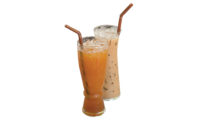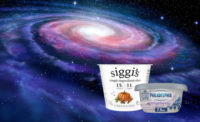As consumers turn to products with less sugar, some traditional beverage categories have seen the effects. The $16.6 billion juice sector is not immune.
Dollar sales for refrigerated orange juices contracted 4.5% to $2.9 billion in U.S. supermarkets, drug stores, mass merchandisers, gas and convenience stores, military commissaries, and select club and dollar retail chains for the 52 weeks ending Oct. 8, 2017, according to data from Chicago-based market research firm IRI.
“Juice and juice drinks have experienced mostly lackluster performance in recent years, impacted by a variety of factors, including high calories and sugar content, comparatively high prices and limited innovation,” said Gary Hemphill, managing director of research for New York-based Beverage Marketing Corporation (BMC). “Orange juice and grapefruit juice have struggled to grow in recent years. Orange especially is connected to morning consumption. With fewer people taking the time to have breakfast at home, sales have suffered.”
And in its May 2017 report titled “Juice and Juice Drinks — US,” Chicago-based Mintel also points to flattened sales for the category and segments.
“Total sales of juice, juice drinks and smoothies reached an estimated $19.8 billion in 2016; compared to 2011, the total juice market grew by less than 3 percent,” the report states.
Despite the fact that 78% of surveyed consumers said they had purchased 100% juice in the prior three months, 100% juice continues to experience year-on-year sales declines, the report notes.
“… 100 percent juice may be pigeonholed as just a breakfast beverage. Additionally, juice drinks may deliver more flavor and excitement, meaning consumers may choose juice drinks over 100 percent juice,” the report states. “While 100 percent juice contains natural ingredients, its high sugar content may prevent more frequent consumption. Changes to nutritional labels may work in favor of 100% juice, but the segment faces a difficult uphill battle to increase sales.”
The good news? Although the juice and juice drinks markets have experienced losses in consumer penetration, the declines have begun to flatten out, said Kevin Weissheier, consumer insights executive at New York-based Kantar Worldpanel.
“[O]ver the past year, consumers have increased their education around fruit-based beverages and are more willing to look past the higher calories for the nutritional benefits that come from them,” Weissheier explained. “While orange juice has been in a rather steady decline, there has been a notable increase in lemonade consumption. Consumers are turning to lemonade, referencing its cleansing and purifying properties … as an alternative to typical consumption.
Jordan Rost, vice president of consumer insights for New York-based Nielsen, also noted the “pockets of opportunity” within the fruit drinks aisle.
“Despite an overall declining category, shelf-stable pineapple and tropical fruit drinks saw dollar sales growth in the latest 52-week period, [ending] Oct. 28, 2017, up 19% and 7.5%, respectively,” he said.
Natural appeal
The consumer shift toward products with healthful, natural and functional attributes is impacting the juice and juice drinks category, analysts noted.
“Health and wellness cuts two ways for juice,” BMC’s Hemphill said. “On the one hand, consumers appreciate that the products are natural and agriculturally based, but they also are generally high in sugar and calories as well as premium priced.”
Yet, premium juices — which tend to be lower in sugar content and organic or natural — are getting a boost from their healthier-for-you positioning, Susan Viamari, IRI’s vice president of thought leadership, said.
“Super-premium [juice] is a strong point in the industry, with momentum provided by probiotics and teas and thirst-quencher drinks,” she noted. “Consumers are looking for healthier options. While juice is seen as healthier than other beverages such as carbonated soft drinks, there is still concern about the sugar content in juice. For this reason, ‘other juices’ [are] seeing the strongest growth.”
“Other juices,” as defined by IRI, include healthier alternatives such as coconut water, natural/organic juices and lower-sugar options such as juice/tea or fruit/veggie blends, Viamari said.
“There is also a movement toward more simplified ingredients,” she noted, “such as products that have no high-fructose corn syrup, no preservatives, no artificial flavors, etc.”
Ready-to-drink teas such as kombucha and other drinks that provide probiotics are seeing a lot of momentum because they provide a low-sugar, natural and refreshing energy or nutritional boost, Viamari added.
Mintel’s report notes that many growing brands within the juice drink segment are hybrid beverages and specifically highlights carbonated juice drinks.
“The simple addition of carbonation may make a juice more appealing for non-morning dayparts,” the report states. “One example of this is Ocean Spray Sparkling, a canned sparkling juice drink.”
The rise of cold-pressed juices within the premium juice segment also is presenting opportunity.
Tsamma Watermelon Juice, a brand of Keenes, Ill.-based Frey Farms, recently launched a new addition to its cold-pressed watermelon juice lineup: Tsamma Watermelon + Coconut Water Blend, which provides potassium and L-citrulline, an amino acid that helps to reduce muscle fatigue, increase muscle recovery and fuel hydration, the company said.
Clean solutions
Consumers’ demand for clean-label and functional refreshment continues to impact not only the juice and juice drinks category, but also the entire food and beverage market, Kantar’s Weissheier said.
“Functionality, which is a major buzzword in the food and beverage community, has also played a role in fruit juice and drinks’ revival,” he explained. “Consumers want more from their beverages — energy, alertness and hydration, for instance — and are turning to their drinks to do so.”
To appeal to consumers’ desires for healthy beverages, juice manufacturers should spotlight attributes that will entice those consumers, experts noted.
“Juice drink manufacturers will need to innovate their products to promote any and all health benefits and ‘call out’ better-for-you ingredients such as no/low sugar or free from artificial colors,” Nielsen’s Rost said. Although most shelf-stable juice drinks contain added sugars, the use of natural alternative sweeteners might create opportunity for beverage-makers.
“The data show that consumers care about the glycemic index in products,” Rost explained. “This creates opportunity for manufacturer innovation by using alternative sweeteners. Organic cane sugar syrup, organic agave nectar, honey, chocolate and vanilla extracts are just a few examples … that can be used to sweeten products and still keep within the low glycemic range.”
In the future, juices with exotic flavors and the addition of fruit juice to other products might help the category resonate, Kantar’s Weissheier said.
“Future innovation is looking toward adding fruit juice to other categories,” he noted. “For instance, we’ve seen fruit juice added to sparkling water [and] tea, and now coffee is on the rise.”
The content in this article originally appeared in Beverage Industry, a publication of the Food Beverage Packaging group of BNP Media, publisher of Dairy Foods. Dairy Foods condensed and edited the content.



.png?height=200&t=1663254269&width=200)
